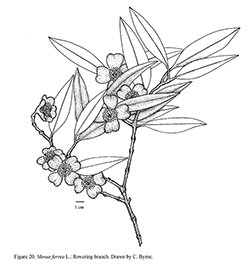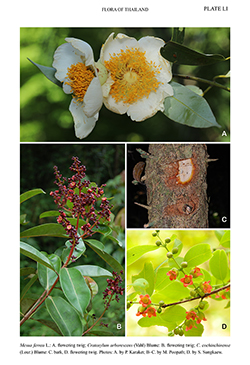e-Flora of Thailand
Volume 14 > Part 3 > Year 2019 > Page 473 > Calophyllaceae > Mesua
Mesua ferrea L.wfo-0001296121
Sp. Pl. 1: 515. 1753; Burm.f., Fl. Ind. [N. L. Burman]: 121. 1768; Choisy, Prodr. [A.P.de Candolle] 1: 562. 1824; Wight, Prodr. Fl. Ind. Orient.: 102. 1834, Icon. Pl. Ind. Orient.: pl. 118. 1839; Thwaites, Enum. Pl. Zeyl.: 5. 1858; Miq., Fl. Ind. Bat. 1(2): 509. 1859; Planch. & Triana, Ann. Sci. Nat., Bot. Sér. 4, 15: 299. 1861; T.Anderson in Hook.f., Fl. Brit. India 1(2): 277. 1874; Kurz, Forest Fl. Burma 1: 97. 1877; Pierre, Fl. Forest. Cochinch. 1: pl. 97. 1885; Vesque, Monogr. Phan. [A.DC. & C.DC.] 8: 630. 1893; Prain, Bengal Pl. 1: 246. 1903; Brandis, Indian Trees: 55. 1907; Pit. in Fl. Indo-Chine [P.H.Lecomte et al.] 1(4): 328. 1910; Gamble, Fl. Madras 1: 77. 1915; Haines, Bot. Bihar Orissa 2: 55. 1921; Ridl., Fl. Malay Penins. 1: 192. 1922; Kamjilal, Fl. Assam 1: 111. 1934; Gagnep. in Humbert, Fl. Gen. Indo-Chine Suppl. 1(3): 277. 1943; Whitmore, Tree Fl. Malaya 2: 227. 1973; Kosterm. in Dassan., Rev. Handb. Fl. Ceylon 1: 107. 1980; P.F.Stevens, Taxon 35(2): 353. 1986; H.W.Li et al., Fl. China 13: 38. 2007; S.Gardner et al., Forest Tree S. Thailand 1: 300, f. 446. 2015; C.Byrne et al., Thai Forest Bull., Bot. 46(2): 192. 2018. Fig. 20. Plate LI: A.
Accepted Name : This is currently accepted.
Synonyms & Citations :
Description : Evergreen trees up to 30 m tall, often fluted at base; outer bark ash-grey, turning dark dull brown, scaly, irregularly fissured, inner bark brownish red to pink or red; with honey coloured exudate, aromatic; sapwood creamy white to pinkish brown; heartwood dark red, hard, tough and heavy. Youngest twigs slender, grey and terete. Leaves very variable, linear lanceolate, oblong-laceolate, lanceolate to narrowly elliptic-oblong, 1–18(–22) by 1–15 cm; base acute or obtuse; apex acute, acuminate to cuspidate; coriaceous or delicate; veins inconspicuous; young leaves pink, mature leaves green adaxially, glaucous and pruinose beneath with white wax abaxially; petiole 0.4–1.2 cm long. Flowers solitary, occasionally in pairs, axillary and terminal; peduncles short, 0.8–2.3 cm long, sweet scented. Sepals light green to pinkish green, 4, orbicular, 1.2–1.5 cm long, imbricate in bud, small outer pair and larger inner pair; persistent, densely velvety puberulous outside. Petals white to pinkish white, 4, cuneate, obovate or obcordate, 1.6–4 cm long, curled and erose at the margins; caducous. Stamens numerous; filaments yellow, slender filiform; anther orange-golden-yellow, 4–10 mm long. Ovary ovoid, up to 5 mm, 2-locular; style ca 1 cm long; stigma peltate. Fruits dark orange or purple/brown, ovoid to ellipsoid with conical point, 2.5–4 cm; crowned with the enlarged calyx, pericarp tough. Seeds 1–4, up to 2.4 cm, woody, smooth, glossy brown, oily.
Thailand : NORTHERN: Mae Hong Son, Chiang Mai, Sukhothai; CENTRAL: Krung Thep Maha Nakhon (Bangkok); SOUTH-EASTERN: Chanthaburi; PENINSULAR: Ranong, Surat Thani, Phuket, Krabi, Nakhon Si Thammarat, Trang, Yala, Narathiwat.
Distribution : India, Sri Lanka (type), Bangladesh, Myanmar, Cambodia, Laos, Vietnam, Peninsular Malaysia, Borneo, Java, the Philippines.
Ecology : Usually in evergreen forests, 10–1,050 m alt. Flowering: Febuary–May; fruiting: May–October.
Vernacular : Ka-ko (ก๊าก่อ), kam-ko (ก้ำก่อ), bun nak (บุนนาค), mai bun nak (ไม้บุนนาก), pa-na-kho (ปะนาคอ), saraphi doi (สารภีดอย).
Uses: The wood is one of the strongest woods found in Asia and is used for construction work, for railway sleepers and in boat building. The seed oil is used for soap making and the flowers and flower buds are used in cosmetics and perfumery. In India the leaves and flowers are also used as hair decorations and the fruits are sometimes eaten.


